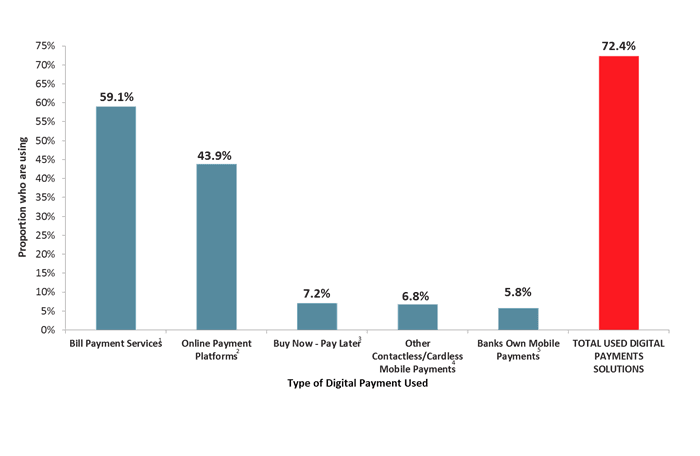72% of Australians use digital payments, with non-bank apps preferred


Australians are embracing buy now, pay later platforms and digital payment wallets over their own bank apps.
A new survey from Roy Morgan has revealed that three-quarters of Australians (72.4%) are embracing digital payment solutions such as Afterpay, Zip and mobile payment wallets. The results come as both fintech companies and established financial institutions continue to offer Australians new and more convenient ways to send and receive money, spend in another country and manage their own finances.
The survey, which was based on face-to-face interviews with over 50,000 consumers in their homes, considered a number of products to be digital payment solutions. This included bill payment services such as BPay; online payment platforms such as PayPal and Visa Checkout; buy now, pay later platforms such as Afterpay and Zip; contactless and cardless mobile payment options such as Google Pay and Apple Pay; and banks' own mobile payment options.
Bill payment services were the most widely used, with 59.1% of Australians having used them in the past 12 months. This was followed by online payment platforms such as PayPal, Visa Checkout and Western Union with 43.9% of Australians using them over the course of the year.

Source: Roy Morgan
The numbers dropped significantly for the next three payment options. However, this changed when broken down by generation. For example, 7.2% of Australians said they used buy now, pay later platforms in the past year but this increased to 11.6% for generation Z and 11.4% for millennials.
Similarly, only 6.8% of Australians said they had used contactless payments or cardless mobile payments in the past 12 months, but this increased to 10.6% for generation Z and 10.4% for millennials.
Australians in general seem to prefer digital wallets such as Google Pay and Apple Pay over the solutions offered by their bank. 6.8% of consumers had used contactless/cardless mobile payments in the past 12 months compared to 5.8% for those that had used a mobile payment solution from a bank.
Industry communications director of Roy Morgan Norman Morris said that new fintech products may pose a threat to more established players.
"The increasing use of new payment technologies is being aided by the growing proliferation and development of smartphones and wearables with integrated technology such as Apple Pay and Google Pay, and an increasing number of financial institutions enabling their customers to make payments with these devices," Morris said.
"All these changes pose a threat to traditional payment types such as credit cards and cash as consumers in effect can access small amounts of credit instantly. Consumers will increasingly want simplified and convenient payment systems and the industry will need to adapt to these expectations by providing more innovative solutions. Traditional financial institutions may need to collaborate with fintechs and other third parties to keep up with the rapidly changing digital payment environment."
Latest fintech news
Picture: Shutterstock

